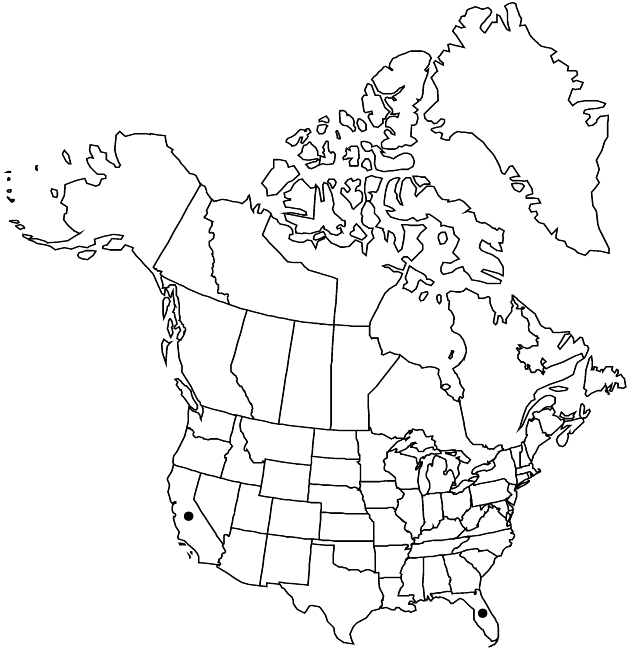Difference between revisions of "Conyza floribunda"
in A. von Humboldt et al., Nov. Gen. Sp. 4(fol.): 57. 1818.
4(qto.): 73. 1820.
FNA>Volume Importer |
imported>Volume Importer |
||
| Line 9: | Line 9: | ||
|place=4(qto.): 73. 1820 | |place=4(qto.): 73. 1820 | ||
|year=1820 | |year=1820 | ||
| + | }} | ||
| + | |special_status={{Treatment/ID/Special_status | ||
| + | |code=I | ||
| + | |label=Introduced | ||
}} | }} | ||
|basionyms= | |basionyms= | ||
| Line 34: | Line 38: | ||
|elevation=10–100 m | |elevation=10–100 m | ||
|distribution=Calif.;Fla.;Mexico;Central America;South America;Europe;Asia;Africa. | |distribution=Calif.;Fla.;Mexico;Central America;South America;Europe;Asia;Africa. | ||
| + | |introduced=true | ||
|discussion=<p><i>Conyza floribunda</i> is thought to be native to South America.</p><!-- | |discussion=<p><i>Conyza floribunda</i> is thought to be native to South America.</p><!-- | ||
--><p>In some floras of the past 50 or so years, <i>Conyza</i> bilbaoana has been treated as distinct from <i>C. floribunda</i>; in others, C. bilbaoana and <i>C. floribunda</i> have been treated as synonyms of <i>C. bonariensis</i>. For some traits (e.g., indument, phyllaries, florets), members of <i>C. floribunda</i> are intermediate to <i>C. bonariensis</i> and <i>C. canadensis</i>; some specimens that I have called <i>C. floribunda</i> may be hybrids. For example, a robust specimen from Santa Cruz Island, California, was originally labeled “<i>C. bonariensis</i> ×canadensis (?).” Locally (e.g., in Berkeley, California), <i>C. canadensis</i> usually comes into flower as <i>C. bonariensis</i> goes to seed. So far as sampled, <i>C. canadensis</i> is diploid; <i>C. bonariensis</i> is hexaploid. Pollen stainability in the Santa Cruz Island specimen is ca. 99%.</p><!-- | --><p>In some floras of the past 50 or so years, <i>Conyza</i> bilbaoana has been treated as distinct from <i>C. floribunda</i>; in others, C. bilbaoana and <i>C. floribunda</i> have been treated as synonyms of <i>C. bonariensis</i>. For some traits (e.g., indument, phyllaries, florets), members of <i>C. floribunda</i> are intermediate to <i>C. bonariensis</i> and <i>C. canadensis</i>; some specimens that I have called <i>C. floribunda</i> may be hybrids. For example, a robust specimen from Santa Cruz Island, California, was originally labeled “<i>C. bonariensis</i> ×canadensis (?).” Locally (e.g., in Berkeley, California), <i>C. canadensis</i> usually comes into flower as <i>C. bonariensis</i> goes to seed. So far as sampled, <i>C. canadensis</i> is diploid; <i>C. bonariensis</i> is hexaploid. Pollen stainability in the Santa Cruz Island specimen is ca. 99%.</p><!-- | ||
| Line 63: | Line 68: | ||
|publication title=in A. von Humboldt et al., Nov. Gen. Sp.; | |publication title=in A. von Humboldt et al., Nov. Gen. Sp.; | ||
|publication year=1818;1820 | |publication year=1818;1820 | ||
| − | |special status= | + | |special status=Introduced |
| − | |source xml=https:// | + | |source xml=https://bibilujan@bitbucket.org/aafc-mbb/fna-data-curation.git/src/bb6b7e3a7de7d3b7888a1ad48c7fd8f5c722d8d6/coarse_grained_fna_xml/V19-20-21/V20_805.xml |
|tribe=Asteraceae tribe Astereae | |tribe=Asteraceae tribe Astereae | ||
|genus=Conyza | |genus=Conyza | ||
Revision as of 20:52, 27 May 2020
Plants erect, 30–150+ cm, branched mostly distally. Leaves: faces sparsely strigose to hispidulous or glabrate (margins ± ciliolate proximally, hairs erect, on nerves); proximal narrowly oblanceolate to linear, 50–100 × 5–15 mm, toothed or entire; distal similar, smaller, entire. Heads in paniculiform or corymbiform arrays. Involucres 3–4 mm. Phyllaries usually sparsely strigose (at least the outer; margins chartaceous to scarious), outer greenish, becoming reddish brown, lanceolate, shorter, inner stramineous to reddish, lance-attenuate. Receptacles 1–2+ mm diam. in fruit. Pistillate florets 30–40+; corollas ± equaling or surpassing styles, laminae 0 or to 0.3 mm. Disc florets 10–20+. Cypselae pale tan (usually some with reddish nerves), 1–1.5 mm, faces sparsely strigillose or glabrate; pappi of 15–25 white bristles 2–3 mm. 2n = 18; 54 or 56.
Phenology: Flowering summer–fall.
Habitat: Disturbed sites
Elevation: 10–100 m
Distribution

Introduced; Calif., Fla., Mexico, Central America, South America, Europe, Asia, Africa.
Discussion
Conyza floribunda is thought to be native to South America.
In some floras of the past 50 or so years, Conyza bilbaoana has been treated as distinct from C. floribunda; in others, C. bilbaoana and C. floribunda have been treated as synonyms of C. bonariensis. For some traits (e.g., indument, phyllaries, florets), members of C. floribunda are intermediate to C. bonariensis and C. canadensis; some specimens that I have called C. floribunda may be hybrids. For example, a robust specimen from Santa Cruz Island, California, was originally labeled “C. bonariensis ×canadensis (?).” Locally (e.g., in Berkeley, California), C. canadensis usually comes into flower as C. bonariensis goes to seed. So far as sampled, C. canadensis is diploid; C. bonariensis is hexaploid. Pollen stainability in the Santa Cruz Island specimen is ca. 99%.
If treated as a variety of Conyza bonariensis, the correct name for the taxon treated here as C. floribunda is C. bonariensis var. leiotheca.
Some botanists, e.g., J. B. Marshall (1974), have treated the nomenclatural types of Conyza floribunda and C. sumatrensis (Retzius) E. Walker (= Erigeron sumatrensis Retzius) as conspecific.